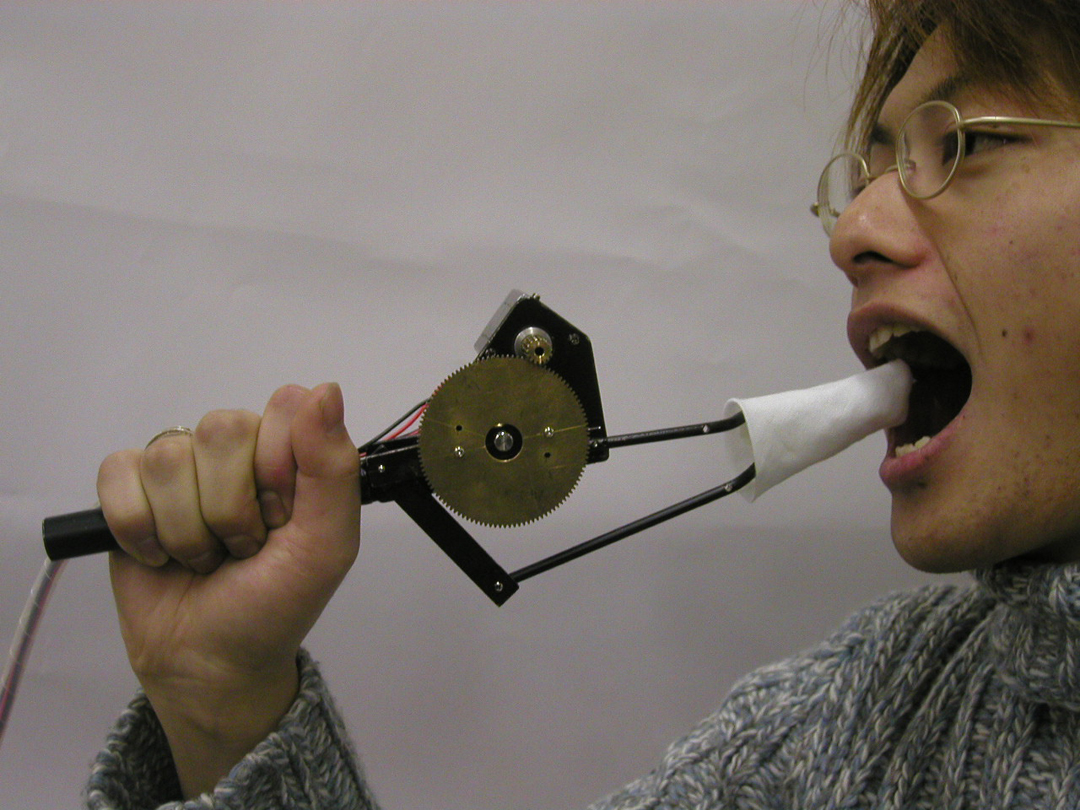“Food Simulator” by Yano, Iwata, Uemura and Moriya
Conference:
- SIGGRAPH 2003
-
More from SIGGRAPH 2003:


Type(s):
E-Tech Type(s):
- Haptics
- Taste & Smell
Entry Number: 08
Title:
- Food Simulator
Presenter(s):
Project Affiliation:
- University of Tsukuba
Description:
Abstract
The Food Simulator is a haptic interface that display biting force. A mechanical linkage is designed to fit to the mouth. The Food Simulator generates force according to the captured force of real food. The system is integrated with auditory and chemical sensation of taste..
1 Introduction
Taste is the last frontier of virtual reality. There have been numerous work on visual and auditory displays. Haptic interface for hand or finger is one of the major research field in virtual reality. Smell display is not popular but flavor can be easily displayed using vaporizer. Taste is very difficult to display because it is multi-modal sensation composed of chemical substance, haptics and sound. Taste perceived by the tongue can be measured using a biological membrane sensor [Toko, K,. et al., 1994]. It can be easily synthesized from five basic taste; sweet, sour, bitter, salty and “Umami.” Remained problem in taste display is haptics. There are some work in measuring biting force [Khoyama,K. et al., 2001 ]. However, the haptic display for biting is not exist.
We developed a novel interface that display biting force. It is designed to fit to the user’s mouth. Configuration of the mechanical linkage is determined considering structure of the jaw. The Food Simulator generates force according to the captured force of real food. A film-like force sensor is used to measure biting force of real food. A force sensor is installed in the Food Simulator and the device is actuated using force control method.
2 Technical Innovation of the Project
We developed a novel interface that display biting force. It is designed to fit to the user’s mouth. Configuration of the mechanical linkage is determined considering structure of the jaw. Curved shape of the linkage enables force application to the back teeth. The Food Simulator generates force according to the captured force of real food. A film-like force sensor is used to measure biting force of real food. A force sensor is installed in the Food Simulator and the device is actuated using force control method. The profile of the biting force of the real food is realized by force control of the device.
The Food Simulator is integrated with auditory and chemical sensation of taste. Sound of biting is captured by a bone vibration microphone. The sound is displayed using a bone vibration speaker. It is synchronized with biting action. Chemical sensation of taste can be displayed using a micro injector installed in the end effecter. The chemical sensation is synthesized from five elements of basic taste; sweet, sour, bitter, salty and “Umami.” Smell is one of the chemical sensations of taste. It can be displayed using vaporizer.
3 Larger implications of the project beyond this demonstration phase
There are many application areas for the Food Simulator. For example:
(1) Training
The Food Simulator can be programmed to generate various forces other than that of real food. Elderly people can practice biting in reduced resistance to the teeth. On the other hand, increased resistance enables younger people to experience difficulty in biting of elderly people.
(2) Entertainment
The Food Simulator can change properties of food while chewing. A cracker can be suddenly changed into a gel. The user enjoys funny experience on chewing. This kind of entertainment contributes to chewing capability of children.
(3) Food design
Preferred resistance to the teeth can be found using the Food Simulator. The findings contributes to designing a new food.
Other Information:
References
Toko, K., et al., Taste Sensor Using Electric Potential Changes in Lipid Membranes, Biosensors and Bioelectronics, Vol.9, pp.359-364(1994)
Kohyama, K. et al.: Patterns observed in the first chew of foods with various textures. Food Sci. Technol. Res., 7(4), 290-296 (2001).
Keyword(s):
- haptics
- taste
- biting force
- force capture




